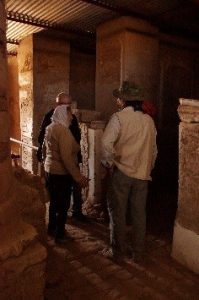
In front of the Polish Unit in the SNM.
We, Dobrochna and Gertrud were in Sudan from 3rd to 24th of January. Unfortunately, Adam could not join us.

Wall paintings from Faras in the SNM.
We worked for a week in the Sudan National Museum (SNM), studying and discussing the wall paintings in the gallery and in the store room. The SNM houses the largest collection of wall paintings excavated and taken from the walls during the International Campaign to Save the Monuments of Nubia of the 1960s.
Most paintings come from the Faras Cathedral (the other half of the paintings excavated by the Polish team is now in Warsaw), but there are also paintings from the tiny church of Abd l-Gadir, the Church of Meinarti, and, outside our research area, the churches of Sonqi Tino and Kulbnarti.


Tea in the cafeteria of the museum.
Apart from the study of paintings in churches in Nobadia, this trip was also intended to study paintings and architecture in Makuria, as a comparison and possible source of influence to Nobadia and southern Egypt.

Therefore we headed north and visited the Monastery of Ghazali (6th-11th century), which was excavated by a Polish team under direction of Artur Obłuski (the publication is expected this summer).

The church of the Monastery of Ghazali.
Located in Wadi Abu Dom, with only a few houses of the care taker and his family in the neighbourhood, it is a hidden gem. Architecturally, the plan of the settlement has features in common with the Monastery at Qasr al-Wizz near Faras and Dayr Anba Hadra near Aswan.

North-Western Annex of the Monastery at Kom H. At the back is a painting of an archangel.
We have spent five days with the Polish archaeological mission at Old Dongola for a study of the wall paintings in the Monastery at Kom H, the so-called Throne Hall and in the Church of the Archangel Raphael. Dobrochna worked at Dongola for years and was warmly greeted by old acquaintances. For me it was the first meeting with wall paintings I knew from photographs and publications. And again, it struck me how different it is to see paintings in situ, and how essential it is to do so. Photographs can be deceptive: colours take another hue, dimensions are difficult to assess, and the size and height of rooms and spaces cannot be taken into account.

An interior view of the North-Western Annex of the Monastery at Kom H.
For example, to see the warren of tiny rooms (covered with paintings) in the South-West and North-West Annexes of the monastery on a plan does not compare to walking in the buildings. It feels, in fact, rather claustrophobic and the size and location of the paintings are bigger, smaller and higher or lower than you might expect. It also makes you wonder about the function of this part of the building complex (not yet completely clear).
The northern church of the monastery, recently discovered, has a very interesting architecture and a choice of pictorial themes which echoes compositions found in Egypt. The colours are vibrant (orange, yellow) and St. John the Baptist looks a bit like a Turkish pasha.

The so-called Throne Hall on the citadel at sunset.
The archangels in Church of the Archangel Raphael (Church BV) are impressive, in composition as well as in number. This majestic church is situated at the edge of the citadel and overlooks the Nile.

Visit at Banganarti Church: Tomasz Derda, Ewa Parandowska, Bogdan Żurawski and Dobrochna.
With Tomasz Derda we paid a visit to Banganarti where we were warmly received by Bogdan Żurawski and his team. They had just arrived a few days earlier and were preparing to start work. Bogdan and restorer Ewa Parandowska gave us an extended tour in the church.
After an extensive farewell to the Polish team at Old Dongola we travelled back to Khartoum…

… where I gave a lecture at the SNM on 23rd January.

After saying goodbye to Dr. Abdelrahman Ali Mohamed, Director General of the National Corporation for Antiquities and Museums (see photograph) and all colleagues at the museum, we ended our last day with a shopping expedition to the souk in Omdurman.
The next day, we went from c. 38° C in Khartoum to a thick layer of snow in Warsaw…
It was a very intensive and inspiring trip.

With many thanks to Dr. Abdelrahman, the staff at the SNM, George and his family of the Acropole Hotel, the Polish archaeological missions at Old Dongola and Banganarti and the countless friendly people we met and who helped us. And last but not least: Dobrochna! She organized this research visit.
